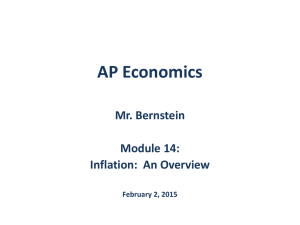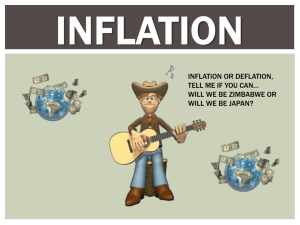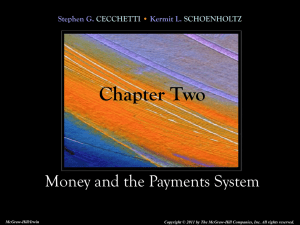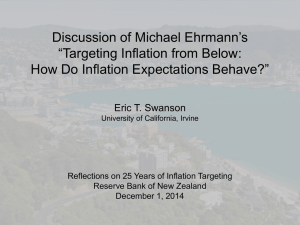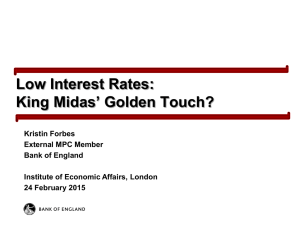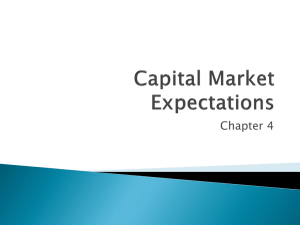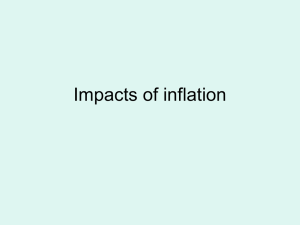Macroeconomic Stabilization Policy
advertisement
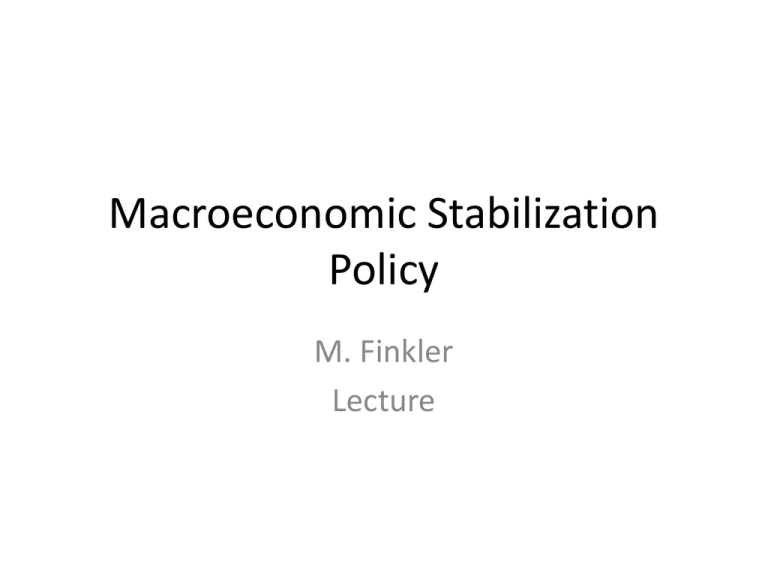
Macroeconomic Stabilization Policy M. Finkler Lecture Goals for Macro Stability • Keep inflation low enough to not affect decision making • Keep GDP close to GDP Potential • Dual Mandate – 1977 Congressional amendment to the Federal Reserve Act – “The Board of Governors of the Federal Reserve System and Federal Open Market Committee shall maintain long run growth of monetary and credit aggregates commensurate with the economy’s long run potential to increase production, so as to promote effectively the goals of maximum employment, stable prices, and moderate long term interest rates.” • January 25, 2012, FOMC noted that “the maximum level of employment is largely determined by non-monetary factors that affect the structure and dynamics of the labor market.” Fundamental Positions of Economists on Macroeconomic Stabilization • Economy is self-correcting; aim policies towards long run growth (freshwater school) • Economy is unstable; use policy in a countercyclical fashion (saltwater school) • Majority of economists favor the latter view Inflation • A substantial (3%+), sustained (1 year or more) rise in the average level of prices • Debate about which target: CPI, PCE, GDP Deflator, asset prices • Why worry about inflation? Both pure and impure inflation have costs. Pure Inflation • Pure: all nominal variables rise together (adjusted by some price index) • Indexing may not be complete or rapid • Menu & shoe leather costs exist (even in a virtual world) • Resources must be devoted to protection against inflation (e.g., TIPS inflation premium) Impure Inflation • Tax system is not neutral – it taxes some nominal gains not just real gains • Not all inflation can be predicted • Inflation generates winners and losers – – – – Borrowers win from rising (unexpected) inflation Lenders lose from rising (unexpected) inflation Well off can more easily protect selves Losers attempt to shift losses onto others • Inflation has been used to reconcile competing claims against income – If debt service payments can’t be met, inflation makes it possible, but then lenders lose – Currency devaluation causes foreign debt holders to lose Costs of Inflation • Over time, lenders put in a risk premium to protect themselves against unexpected inflation • Inflation and uncertainty tend to rise together – Risk averse firms postpone hiring and K purchases • Rampant inflation reduces confidence and destabilizes economies: Chile (1970s), Nicaragua and Peru (1980s), Eastern Europe (1990s), and Zimbabwe (2000s). Argentina? Active vs. Passive Policy • Active (Keynesian) – Use AD Management tools to stabilize Π, Y, and L – Possible to intervene to reduce Y and L losses – Business cycles have been less volatile since WWII • Passive (New Classical, Real Business Cycle) – Set policy for the long run – Active policy inhibits structural adjustment – Relative prices become distorted and moral hazard increases – C. Romer – Less volatility since WWII? - better data – Activist policy can be manipulated by the party in power for political purposes Policy Lags • Inside lag – time required to make a decision and implement policy • Outside lag – time required for policy to affect desired variables • Monetary policy has short inside lag and long outside lag (various transmission channels) • Fiscal policy inside lags tend to be long (except in an emergency), but outside lags can be short. (Spending and taxing changes can be quickly implemented) Automatic Stabilizers • Progressive income tax system (rates rise with income) dampens booms and softens contracting periods • Unemployment insurance does the same thing (recall: C. Zimmerman discussion) • Typically specific conditions (not decisionmaking) generates policy response so no inside lag. (Unemployment compensation, agricultural price supports) Timing • Forecasting is very difficult so discretionary policy intervention can be mistimed or inappropriate • Leading indicators often give false signals (need 3 or more same sign before odds of correct signal > 50%) • R2 not helpful – only 11 recessions since WWII • Turning points are very hard to predict Lucas Critique • Keynesian policy makers argue that policy makers need not worry about how households and businesses will perceive policy • Lucas argued that HH and firms anticipate policy in making long term commitments – Will there be a tax reduction or increase? – Will there be incentives to hire more labor? – Will there be incentives to invest in plant and equipment? • Essentially, moral hazard must be considered. (Bailouts, subsidies, tax incentives) • Lucas (New Classicists) argue for clearly articulated and credible policies; these reduce uncertainty. Rules versus Discretion • Activist rules: those which attempt to be countercyclical – e.g. Taylor’s FFR rule • Passive rules: those which don’t change with the state of the economy (except under very unstable conditions) – e.g. Friedman’s k% rule • Discretion provides flexibility to policy makers to respond as they see fit without being bound to specific actions. Discretion • Treasury Secretary Paulson (2008) • Who is “Too Big to Fail”? Which forces are systemic? Who gets “bailed out”? • Fed intervened when Bear, Stearns was headed for bankruptcy. It did not for Lehman Brothers. • Former case meant that latter was a surprise. • Discretion can lead to political manipulation based on election cycle, lobbying, and size of stakeholder interest (GM? AIG?) Time Inconsistency • If policy makers have discretion, they might optimize choice at each point in time rather than establish a long term policy. • For example, they might declare π* = 2%, wait until contracting is done and then implement policy that is more expansionary • If π expectations are backward looking, it doesn’t matter. • If π expectations are forward looking, it does so credibility of target is critical. Credibility • John Taylor (EROP 1990) : – “Policy credibility will often lead to economic performance that is superior to that in which policy is not credible. …A credible disinflation plan initiated by the monetary authorities will bring down inflation more quickly and with less chance of recession than a plan with little credibility.” – “If the public is confident that appropriate policies are being followed, then households and businesses can plan for the future, which promotes savings, investment, and economic growth.” Independence of Central Bank • Until recently, consensus view has been that the CB should be independent of treasury • Note that fiscal policy and monetary policy in conflict means incoherent policy. • Figure 18-2 should independence matters for CB • New Zealand is often the most frequently cited case • Canada, UK, and ECB have announced targets. Not clear that they follow them. Kydland and Prescott • Let U = Un – α*(π- πe) + ε - Phillips Curve • CB objective to minimize welfare loss which could be L(U, π) = U + γ* π2 • Derivative of L wrt π, set to zero yields π= α/2 γ • If public knows & believes π* = 2% then πe= πe and U = Un + ε • Time inconsistency says get people to believe that inflation target is credible and then implement expansionary policy. Note: Japan.



